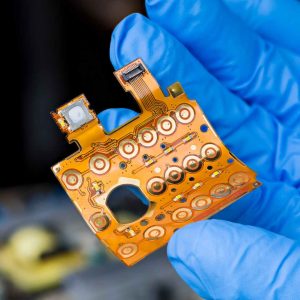In the world of electronics manufacturing, the ultimate goal is to ship a product that works perfectly, every single time. A successful assembly process, guided by rigorous quality controls like Automated Optical and X-Ray Inspection, gets us most of the way there. But the final, non-negotiable gatekeeper of quality is post-assembly testing. It is the definitive process that verifies not just that a Printed Circuit Board (PCB) was built correctly, but that it functions correctly. In the realm of automated testing, two primary methodologies dominate: In-Circuit Testing (ICT) and Functional Testing (FCT). While both aim to identify faults, they approach the task from fundamentally different perspectives. Understanding the difference between them, their unique strengths and weaknesses, is crucial for developing an effective and cost-efficient test strategy. Choosing the right approach is not a matter of one being universally “better,” but of selecting the right tool for the job. As a dedicated American manufacturing partner, BENCOR collaborates closely with our clients to develop and implement the optimal test strategy, ensuring every product we build is verified to the highest standards of quality and reliability.

In-Circuit Testing (ICT): A Structural "White Box" Test
Think of In-Circuit Testing as a meticulous electrician performing a comprehensive diagnostic on a building’s wiring before the main power is ever turned on. ICT’s purpose is to verify the structural integrity of the PCB assembly itself. It doesn’t check if the board performs its intended task; it checks that all the individual components are in the right place, correctly oriented, and properly connected according to the schematic.
How ICT Works
- ICT relies on a custom fixture often called a “bed-of-nails.” This fixture is precisely engineered with dozens, hundreds, or even thousands of spring-loaded pins (pogo pins) that are designed to align perfectly with specific test points on the underside of the PCB. During the test, the PCB is pressed firmly down onto this fixture, allowing each pin to make a secure electrical contact.
- An automated test system then sends a series of signals through these pins. It systematically checks for shorts between nets, opens within nets, and measures the values of individual passive components like resistors, capacitors, and inductors. By effectively “isolating” each component in the circuit, it can verify that the correct part was placed and that its value is within tolerance. It can also check the orientation of components like diodes and transistors.
Strengths of ICT
- Exceptional Fault Coverage: ICT is incredibly effective at detecting a very high percentage—often 90% to 98%—of common manufacturing process defects. This includes shorts, opens, missing components, wrong components, incorrectly oriented components, and faulty passive parts.
- Extremely Fast Test Time: Once the board is engaged in the fixture, the entire automated test sequence is completed very quickly, often in under a minute. This high speed makes ICT ideal for high-volume production environments where minimizing test time per board is critical.
- Precise and Immediate Diagnostics: The greatest strength of ICT is the clarity of its feedback. When a fault is detected, the system doesn’t just report a failure; it pinpoints the exact location and nature of the problem (e.g., “Short circuit between pin 5 of U4 and resistor R22”). This precise diagnostic information allows technicians to troubleshoot and repair faulty boards quickly and efficiently, minimizing downtime.
Weaknesses and Considerations for ICT
- High Upfront Cost and Lead Time: The primary drawback of ICT is the custom bed-of-nails fixture. Designing and fabricating this complex, high-precision fixture is expensive and can take several weeks. This high non-recurring engineering (NRE) cost makes ICT less economically viable for low-volume production runs or early-stage prototypes.
- Requires Design for Testability (DFT): For ICT to be effective, the PCB must be designed from the start with testing in mind. This means engineers must strategically place test points on all the circuit nets they wish to verify. These test points consume valuable board space, which can be a challenge on dense designs.
- Does Not Test Functionality: This is a crucial distinction. ICT confirms that the board is a perfect physical representation of the schematic, but it does *not* power up the board in its operational mode. It cannot detect timing issues, signal integrity problems, firmware bugs, or issues that arise from the interaction between multiple components working together at speed.

Functional Testing (FCT): A "Black Box" Test of Performance
If ICT is the electrician checking the wiring, Functional Testing is the homeowner moving in, turning on the power, and making sure all the lights, appliances, and systems work together as expected. FCT’s purpose is to verify the behavior of the PCB assembly. It answers the ultimate question: “Does this product actually do what it was designed to do?”
How FCT Works
- During a functional test, the fully assembled PCB (or the final product in its enclosure) is powered on and interacts with a custom test fixture. This fixture simulates the product’s real-world operating environment. It might provide specific input signals, send data to communication ports, or mimic user actions like button presses.
- The system then measures the outputs from the board, comparing them against the expected results defined in the test plan. For example, it might check for specific voltage levels at certain points, verify that an LED lights up, confirm that the correct data is transmitted from a port, or check that a display shows the proper information.
Strengths of FCT
- Verifies Real-World Performance: FCT is the ultimate confirmation that the product is ready for the customer. It tests the board as a cohesive system, catching the complex issues that ICT misses, such as firmware bugs, signal integrity problems, incorrect component interactions, and problems with power regulation under load.
- Lower Fixture Cost: While FCT requires a custom test fixture, it is often simpler and significantly less expensive to develop than a complex bed-of-nails ICT fixture. This makes it a much more accessible option for low-to-mid volume products and prototypes.
- Tests the Entire Assembled System: FCT is not limited to just the PCB. It is often performed as the very last step on the final, fully assembled product (the “box build”), verifying that all connectors, cables, displays, and user interfaces are working correctly as part of the complete system.
Weaknesses and Considerations for FCT
- Lower Coverage for Manufacturing Defects: While FCT is excellent at catching functional failures, it may not catch all underlying manufacturing defects. A board with a marginal, intermittent solder joint might pass its functional test at the factory, only to fail later in the field. FCT’s fault coverage for purely structural defects is typically lower than ICT’s.
- Potentially Slower Test Time: A comprehensive functional test sequence, which may require the device to boot up and run through various operational modes, can take significantly longer to execute per unit than an ICT test. This can become a bottleneck in very high-volume production.
- Vague Diagnostics: When a board fails a functional test, the immediate result is often simply “pass” or “fail.” The test indicates a symptom (e.g., “no signal from output port”), but it doesn’t pinpoint the root cause (a faulty IC, a cold solder joint, a software bug). This makes troubleshooting and repair a much more time-consuming and skill-intensive process compared to the precise feedback from ICT.

Which is Right for Your Product? A Strategic Decision
The choice between ICT, FCT, or a combination of both is a strategic decision that depends on several factors:
For High-Volume, Mature Products (e.g., consumer electronics):
ICT is often the workhorse.
The high NRE cost of the fixture is easily justified when spread across tens of thousands of units. The fast test time is essential for high-throughput manufacturing, and the precise diagnostics allow for rapid repair, keeping the production line moving. It is typically followed by a quick, final FCT to ensure the units power up and perform their core function.
For Low-Volume, High-Complexity Products (e.g., specialized industrial equipment):
FCT is often the primary choice.
The cost of an ICT fixture may be prohibitive. Here, the focus is less on raw speed and more on guaranteeing the complex functionality of every single unit.
For Prototypes and New Product Introduction (NPI):
FCT is almost always the preferred method.
It is flexible, lower in cost, and directly answers the most important question at this stage: “Does my design work as intended?” For structural verification at this stage, fixtureless methods like Flying Probe testing (a form of robotic, pin-by-pin ICT) are also an option.
For High-Reliability Products (e.g., Medical, Aerospace, Critical Industrial Controls):
A layered strategy using both is the gold standard.
For these applications, where failure is not an option, you need the highest possible level of confidence.
- ICT is used to provide maximum assurance that the board is built perfectly, with no structural defects.
- FCT is then used to provide maximum assurance that the perfectly built board operates perfectly as a system. This combination provides the most comprehensive quality verification possible.

BENCOR: Your Partner in Developing a Smart Test Strategy
At BENCOR, we view ourselves as more than just an assembly house; we are a partner in quality. We know that a one-size-fits-all approach to testing does not work. Our experienced engineering and project management teams work closely with our customers from the outset to develop a test strategy that is both effective and economical for their specific product.
We take a consultative approach, helping you weigh the trade-offs between ICT and FCT based on your product’s complexity, production volume, and reliability requirements. We have the expertise to help design and implement robust custom functional test solutions and the partnerships to facilitate ICT when it is the right choice for your project. This commitment to comprehensive testing is a cornerstone of the high standards of American manufacturing. It is a promise of quality that is not just claimed, but rigorously verified. Building your product in the USA with a partner like BENCOR means building it with a transparent, collaborative, and effective quality assurance plan from start to finish.
Conclusion: In-Circuit Testing and Functional Testing are not competing methodologies but powerful, complementary tools in the quality assurance toolbox. ICT excels at verifying the physical structure of a PCB with speed and precision, while FCT excels at verifying the overall behavior and performance of the final product. The right choice—or combination—depends entirely on the strategic needs of your product. Partnering with an experienced American manufacturer like BENCOR ensures you have an expert guide to help you develop and execute the optimal test strategy, guaranteeing that every product we ship meets the highest possible standards of quality and reliability.




